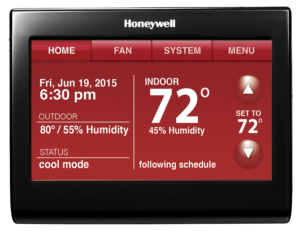Welcome to Ready & Able, formerly known as David LeRoy Plumbing! Although our name and brand have changed, we are still here to serve you and all of your plumbing, heating, cooling, and air quality needs!


Many new homeowners are intrigued by the idea of having a smart thermostat to control the temperature in their home. We receive questions about this all the time. I am writing today to give some much needed insight as to the effectiveness of these “smart” thermostats.
We are also going to discuss the alternative option, WiFi thermostats, because they are very similar and many people do not know the difference.
“A smart thermostat will let me control my homes temperature from anywhere and easily schedule when the heating or cooling should turn on/off.”
Yes, a smart thermostat can let you change the temperature of your home from anywhere, but it is by no means easy to use. The thermostat sometimes becomes almost too smart and thinks it knows your schedule well enough to make these temperature changes on its own. This can be frustrating for a homeowner whose schedule changes and/or their family’s schedule changes frequently.
WiFi Thermostats – The Alternative Solution
A Wi-Fi thermostat can let you change the temperature of your home from an app on your phone, just like a smart thermostat can, and it is not “smart”. This is a much better option for the tech-savvy homeowner at this point in time. The smart thermostats are in the beginning stages of creation and as such, come with many annoyances and bugs the technology must work through. This can be too much for the homeowner and may leave them frustrated with the product and/or the company that installed it, even if said company warned the homeowner ahead of time that these thermostats may be more of a headache than they are worth.
The biggest reason that we, as professional HVAC technicians, do not recommend a smart thermostat is because thermostats should not be that easily adjusted. In order to maintain efficiency and comfort in your home, a thermostat should be programmed once and forgotten. Messing with the temperature too much can cause a spike in your utility bills, and possibly premature breakdowns from your heating or cooling systems. Adjusting the temperature multiple times throughout a day causes your heating or cooling equipment to work a lot harder to change the temperature throughout your whole home, which in turn causes wear and tear on the machine. A thermostat should be put on a schedule and only changed if the homeowners schedule changes from day to day.
The key features that a homeowner usually looks for in a smart thermostat can be just as easily obtained in a WiFi thermostat.
The key difference between the two is the price. On average, most WiFi thermostats are about $100 less than a Smart thermostat.

And best of all, you can get a rebate! First Emergy and Met-Ed offers a $25 mail-in rebate to their customers. Find out more about the Honeywell WiFi 9000 thermostat here. If you want one installed in your home, contact us to schedule an appointment today. (717) 963-2034
Welcome to Ready & Able, formerly known as David LeRoy Plumbing! Although our name and brand have changed, we are still here to serve you and all of your plumbing, heating, cooling, and air quality needs!